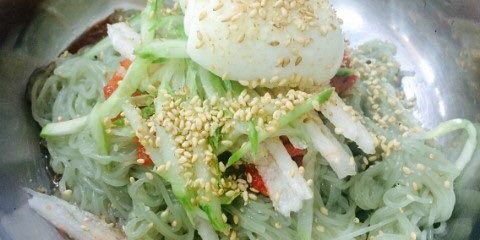Slurping the thin glass noodles of naengmyeon is a delight in itself – the broth is ice-cold and the noodles are easy to the mouth. This is an especially good dish for hot days as it is light, quite unobtrusive and flows easily from the mouth, through the throat and down to your stomach.
The dish has long been part of Korean food history, originating from North Korea’s Pyongyang and Hamheung areas during the Joseon dynasty (subject of many Korean sageuk dramas) and eventually popularized down south after the Korean War.
There are two main types of this chill Korean dish: the mul naengmyeon and bibim-naengmyeon.
Mul-naengmyeon (물 냉면)
The mul-naengmyeon is from Pyongyang and it has been said that Pyongyang’s naengmyeon is the best. No other adjectives for that, but the emphatic declarations from those who have tasted it testified to the quality of this North Korean dish. The buckwheat noodles are paired with a beef broth that is sometimes mixed with dongchimi. This is served with sliced radish. In comparison, the South Korean version of this only uses beef broth.
Bibim-naengmyeon (비빔 냉면)
The bibim-naengmyeon on the other hand is spicy. The bibim-naengmyeon is made spicy by a gochujang-based sauce mixed with the noodles. For this type, the broth is plain and hot and is served separately. In North Korea’s Hamheung area, the hoe naengmyeon is a popular type of bibim-naengmyeon that makes use of marinated raw fish called the hoe. Additionally, what makes this different is the noodle type – where the typical naengmyeon uses buckwheat noodles, the Hamheung version is chewy, it being made from potato or sweet potato starch.
*photo taken by Grey Jang, This is KOREA







